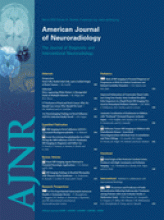Research ArticleNeurointervention
Open Access
Predictors of Surface Disruption with MR Imaging in Asymptomatic Carotid Artery Stenosis
H.R. Underhill, C. Yuan, V.L. Yarnykh, B. Chu, M. Oikawa, L. Dong, N.L. Polissar, G.A. Garden, S.C. Cramer and T.S. Hatsukami
American Journal of Neuroradiology March 2010, 31 (3) 487-493; DOI: https://doi.org/10.3174/ajnr.A1842
H.R. Underhill
C. Yuan
V.L. Yarnykh
B. Chu
M. Oikawa
L. Dong
N.L. Polissar
G.A. Garden
S.C. Cramer

References
- 1.↵
- Sitzer M,
- Muller W,
- Siebler M,
- et al
- 2.↵
- Park AE,
- McCarthy WJ,
- Pearce WH,
- et al
- 3.↵
- Saam T,
- Cai J,
- Ma L,
- et al
- 4.↵
- Yuan C,
- Zhang SX,
- Polissar NL,
- et al
- 5.↵
- Takaya N,
- Yuan C,
- Chu B,
- et al
- 6.↵
- Yuan C,
- Beach KW,
- Smith LH Jr.,
- et al
- 7.↵
- Hatsukami TS,
- Ross R,
- Polissar NL,
- et al
- 8.↵
- Saam T,
- Ferguson MS,
- Yarnykh VL,
- et al
- 9.↵
- Chu B,
- Kampschulte A,
- Ferguson MS,
- et al
- 10.↵
- Mitsumori LM,
- Hatsukami TS,
- Ferguson MS,
- et al
- 11.↵
- Murphy RE,
- Moody AR,
- Morgan PS,
- et al
- 12.↵
- 13.↵
- Takaya N,
- Yuan C,
- Chu B,
- et al
- 14.↵
- 15.↵
- Corti R,
- Fuster V,
- Fayad ZA,
- et al
- 16.↵
- Adams GJ,
- Greene J,
- Vick GW 3rd.,
- et al
- 17.↵
- Roederer GO,
- Langlois YE,
- Yager KA,
- et al
- 18.↵
- Yuan C,
- Kerwin WS,
- Yarnykh VL,
- et al
- 19.↵
- Kerwin W,
- Xu D,
- Liu F,
- et al
- 20.↵
- Nissen SE,
- Tuzcu EM,
- Schoenhagen P,
- et al
- 21.↵
- 22.↵
- Takaya N,
- Cai J,
- Ferguson MS,
- et al
- 23.↵
- Saam T,
- Kerwin WS,
- Chu B,
- et al
- 24.↵
- 25.↵
- Moore WS,
- Barnett HJ,
- Beebe HG,
- et al
- 26.↵
Endarterectomy for asymptomatic carotid artery stenosis: Executive Committee for the Asymptomatic Carotid Atherosclerosis Study. JAMA 1995;273:1421–28
- 27.↵
- Rothwell PM,
- Gutnikov SA,
- Warlow CP
- 28.↵
- Barnett HJ,
- Taylor DW,
- Eliasziw M,
- et al
- 29.↵
- Glagov S,
- Weisenberg E,
- Zarins CK,
- et al
- 30.↵
- 31.↵
- Falk E
- 32.↵
- Seeger JM,
- Barratt E,
- Lawson GA,
- et al
- 33.↵
- Mathiesen EB,
- Bonaa KH,
- Joakimsen O
- 34.↵
- Bernick C,
- Kuller L,
- Dulberg C,
- et al
- 35.↵
- Longstreth WT Jr.,
- Dulberg C,
- Manolio TA,
- et al
In this issue
Advertisement
H.R. Underhill, C. Yuan, V.L. Yarnykh, B. Chu, M. Oikawa, L. Dong, N.L. Polissar, G.A. Garden, S.C. Cramer, T.S. Hatsukami
Predictors of Surface Disruption with MR Imaging in Asymptomatic Carotid Artery Stenosis
American Journal of Neuroradiology Mar 2010, 31 (3) 487-493; DOI: 10.3174/ajnr.A1842
0 Responses
Jump to section
Related Articles
- No related articles found.
Cited By...
- Characteristics of intracranial plaque in patients with non-cardioembolic stroke and intracranial large vessel occlusion
- Roadmap Consensus on Carotid Artery Plaque Imaging and Impact on Therapy Strategies and Guidelines: An International, Multispecialty, Expert Review and Position Statement
- Plaque Composition as a Predictor of Plaque Ulceration in Carotid Artery Atherosclerosis: The Plaque At RISK Study
- Change in Carotid Plaque Components: A 4-Year Follow-Up Study With Serial MR Imaging
- Carotid Plaque Lipid Content and Fibrous Cap Status Predict Systemic CV Outcomes: The MRI Substudy in AIM-HIGH
- Intraplaque Hemorrhage and the Plaque Surface in Carotid Atherosclerosis: The Plaque At RISK Study (PARISK)
- Nonpharmacological Lipoprotein Apheresis Reduces Arterial Inflammation in Familial Hypercholesterolemia
- Intravascular Frequency-Domain Optical Coherence Tomography Assessment of Carotid Artery Disease in Symptomatic and Asymptomatic Patients
- Arterial Stiffness Is Associated With Carotid Intraplaque Hemorrhage in the General Population: The Rotterdam Study
- Prediction of High-Risk Plaque Development and Plaque Progression With the Carotid Atherosclerosis Score
- Blood Pressure Parameters and Carotid Intraplaque Hemorrhage as Measured by Magnetic Resonance Imaging: The Rotterdam Study
- Intravascular Frequency-Domain Optical Coherence Tomography Assessment of Atherosclerosis and Stent-Vessel Interactions in Human Carotid Arteries
- Comparison of Carotid Atherosclerotic Plaque Characteristics by High-Resolution Black-Blood MR Imaging between Patients with First-Time and Recurrent Acute Ischemic Stroke
- Sustained Acceleration in Carotid Atherosclerotic Plaque Progression With Intraplaque Hemorrhage: A Long-Term Time Course Study
- Carotid Atherosclerotic Plaque Progression and Change in Plaque Composition Over Time: A 5-Year Follow-Up Study Using Serial CT Angiography
- Association Between Carotid Artery Plaque Ulceration and Plaque Composition Evaluated With Multidetector CT Angiography
- Discriminating Carotid Atherosclerotic Lesion Severity by Luminal Stenosis and Plaque Burden: A Comparison Utilizing High-Resolution Magnetic Resonance Imaging at 3.0 Tesla
This article has not yet been cited by articles in journals that are participating in Crossref Cited-by Linking.
More in this TOC Section
Similar Articles
Advertisement











